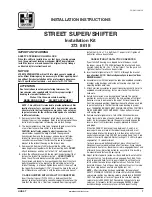
Basic Troubleshooting
When diagnosing a specific problem, organized troubleshooting is a must. The complexity
of a modern automotive vehicle demands that you approach any problem in a logical,
organized manner. There are certain troubleshooting techniques, however, which are
standard:
Establish when the problem occurs. Does the problem appear only under certain
conditions? Were there any noises, odors or other unusual symptoms? Isolate the
problem area. To do this, make some simple tests and observations, and then
eliminate the systems that are working properly. Check for obvious problems, such
as broken wires and loose or dirty connections. Always check the obvious before
assuming something complicated is the cause.
Test for problems systematically to determine the cause once the problem area is
isolated. Are all the components functioning properly? Is there power going to
electrical switches and motors. Performing careful, systematic checks will often
turn up most causes on the first inspection, without wasting time checking
components that have little or no relationship to the problem.
Test all repairs after the work is done to make sure that the problem is fixed. Some
causes can be traced to more than one component, so a careful verification of
repair work is important in order to pick up additional malfunctions that may cause
a problem to reappear or a different problem to arise. A blown fuse, for example, is
a simple problem that may require more than another fuse to repair. If you don't
look for a problem that caused a fuse to blow, a shorted wire (for example) may go
undetected.
Experience has shown that most problems tend to be the result of a fairly simple and
obvious cause, such as loose or corroded connectors, bad grounds or damaged wire
insulation which causes a short. This makes careful visual inspection of components
during testing essential to quick and accurate troubleshooting.
Summary of Contents for TrailBlazer
Page 1: ......
Page 26: ...Fig 3 Typical body and undervehicle maintenance locations Refer to chart for descriptions ...
Page 29: ......
Page 30: ......
Page 31: ......
Page 175: ...Spring free length check Valve spring squareness check ...
Page 192: ...Front of piston mark ...
Page 361: ...5 3L Engine Except Saab Underhood Fuse Block 2003 2005 Early Production ...
Page 469: ...Removing the outer band from the CV boot Removing the inner band from the CV boot ...
Page 470: ...Removing the CV boot from the joint housing Clean the CV joint housing prior to removing boot ...
Page 471: ...Removing the CV joint housing assembly Removing the CV joint ...
Page 472: ...Inspecting the CV joint housing Removing the CV joint outer snap ring ...
Page 473: ...Checking the CV joint snap ring for wear CV joint snap ring typical ...
Page 474: ...Removing the CV joint assembly Removing the CV joint inner snap ring ...
Page 475: ...Installing the CV joint assembly typical ...
Page 553: ...9 Torque the lug nuts to specification 10 Lower the vehicle ...
Page 556: ...Toe in Frame Misalignment Frame misalignment ...
Page 588: ...Bleeding caliper ...
Page 624: ...Manifold gauge set components Refrigerant recovery recycling station ...
Page 676: ...A C Specifications ...
Page 677: ......
















































